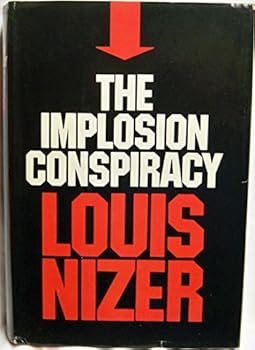The Implosion Conspiracy
Select Format
Select Condition 
Book Overview
Out of Print Collectible Hardcover Fiction This description may be from another edition of this product.
Format:Hardcover
Language:English
ISBN:0385039255
ISBN13:9780385039253
Release Date:January 1973
Publisher:Doubleday
Length:495 Pages
Weight:1.35 lbs.
Related Subjects
True CrimeCustomer Reviews
2 ratings
A Famous Lawyer's Comments
Published by Thriftbooks.com User , 21 years ago
This 1973 book tells of the trial of Julius and Ethel Rosenberg. Nizer usually wrote about his own cases, but decided to research this case with no opinion as to their guilt or innocence. The reason that truth is stranger than fiction in the courtroom is that "fiction is obliged to stick to possibilities; truth isn't" (p.3). A trial is a war fought under civilized rules. Many people have definite opinions about cases from newspaper accounts, but newspapers give only fragments, not the whole case. Judicial opinions are not the means to a conclusion, but a rationalization of a conclusion (p.5). It is possible to take the record of any trial and through post-facto reasoning deduce that the verdict was wrong. But a jury has the right to apply common sense and their observation of the witnesses; this is not recorded. A jury will forgive errors of law, but not of facts. [Do modern trial lawyers concentrate on jury selection to effectively win a case?] Any critic of a case usually has not heard the witnesses testify. [This assumes that the evidence and witnesses were correctly perceived in this or any other trial. Would perjury and planted evidence change this view?]For Nizer the question should be "do you think there was sufficient evidence to decide they were guilty?" The answer is plainly "yes". But if they had been found not guilty, would the same question apply?Louis Nizer was a defender of the Warren Commission Report; would he have learned anything afterwards? Page 6 tells of the finding of a Mauser on the sixth floor of the Book Depository Building. Nizer makes the willful mistake of saying it was another rifle! He wasn't there, and didn't see the published picture, yet he claims to know the real truth! So you should know that Nizer has the fault of seeing what he wants to see.I used to believe that the Rosenbergs were spies and traitors; this book explains that they were never indicted for treason, and never convicted of espionage. I now believe that were scapegoats for a show trial to explain away the loss of America's atom bomb "secret". Russia, like other countries, were involved in atomic research in the 1930s. Some of the scientists at Los Alamos were sending secrets to foreign countries. "The House on 92nd Street" claimed that the atom bomb secret was kept safe by the FBI. There was no mention of Army counter-intelligence. This 490 page book lacks an index and table of contents."Blueprints for Utopia never take into account human frailties. That is why they are so alluring in print and so ineffectual in practice" (p.23). This, and other interesting comments on this case and the law in general make this a good book to read.
The story of a fair trial
Published by Thriftbooks.com User , 24 years ago
Louis Nizer brings the perspective of a lawyer to this review of the Rosenberg trial. He takes you through the trial, day by day, discusses the strategy of the opposing sides, and makes a judgement -- the trial was proper, and the jury was justified in coming to the conclusion that the defendents were guilty. He's also careful to warn you about the things you can't know, such as the difference between reading what was said, and seeing it yourself. The big flaw in this book is the lack of sources. You can't always tell where Nizer got his information. But unless you want to wade through the trial transcript and briefs, this is the best description of the process that led to the Rosenbergs' conviction. It's a fairminded, honest book, and I recommend it.






